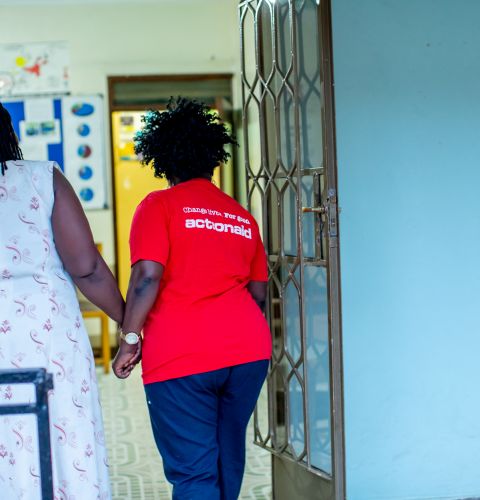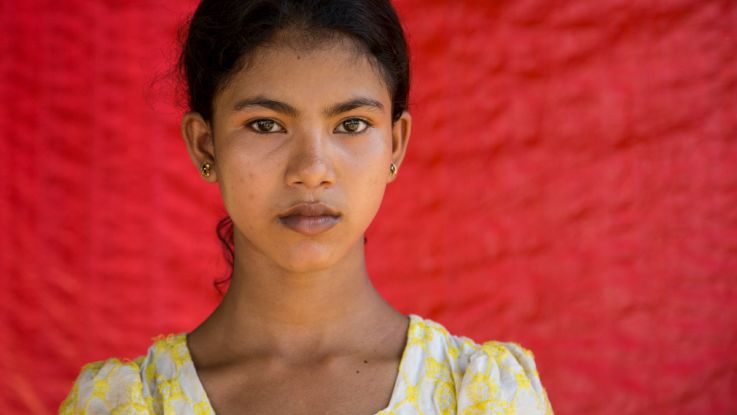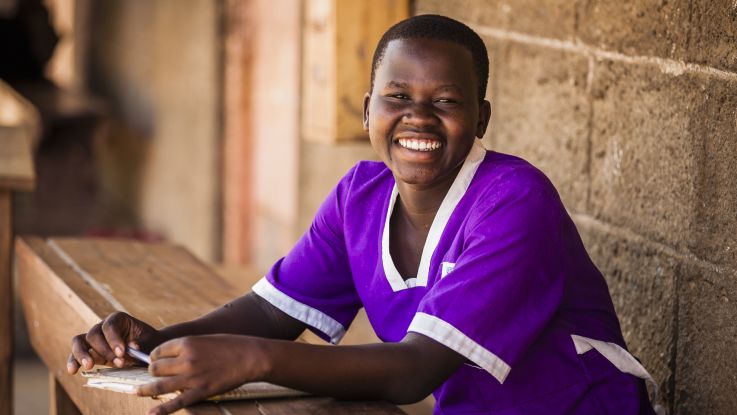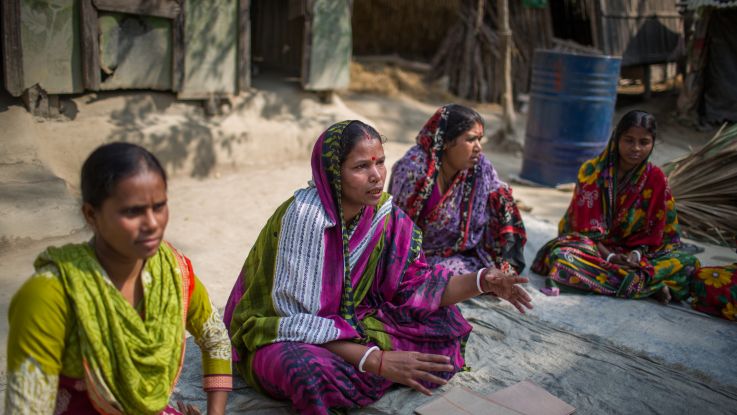Domestic violence and abuse
650 million
Each year, 15 million girls are married before the age of 18. 1There are currently 650 million women alive who married as children.2
47 %
It is estimated that of all women who were the victims of homicide globally in 2012, almost half were killed by intimate partners or family members, compared to less than 6% of men killed in the same year.3
120 million
Around 120 million girls under the age of 20 worldwide (about 1 in 10) have experienced forced sexual acts at some point in their lives.4
Domestic violence by intimate partners
Husbands, boyfriends, male neighbours and relatives are the most likely perpetrators of violence against women and girls.
Domestic violence by husbands, boyfriends or partners (also known as intimate partner violence or IPV) is by far the most reported form of violence against women. In the most extreme cases, it can lead to homicide.
Globally, 38% of all murdered women (in contrast to 6% of all murdered men) are killed by their partner.5
Domestic violence is universal. It is an expression of male dominance over women and it is both a cause and a consequence of women’s serious disadvantage and unequal position in comparison to men. Its impact is felt throughout every layer of society.
ActionAid focuses on tackling domestic violence through supporting survivors, helping them access family planning services, providing them with skills and resources to earn their own income, holding perpetrators to account and ending the patriarchal power structures and harmful practices such as child marriage that help enable abuse in the first place.
How domestic violence affects women and girls living in poverty
Domestic violence is a global problem, but women and girls in poverty are even more at risk. Survivors often can’t afford to go to hospital or get support from the police, and are left dealing with the emotional and physical impacts of the abuse on their own.
ActionAid is committed to ending domestic and other forms of violence against women and girls. Our local workers tackle violence in their communities and help survivors access the services they need and the justice they deserve.
What are the different types of domestic violence?
Domestic violence by partners can take many forms. These are five of the main types of abuse.
- Rape: non-consensual penetration of the vagina, anus or mouth with a penis or other body part – or non-consensual penetration of the vagina or anus with an object.
- Sexual assault: any form of non-consensual sexual contact that does not result in or include penetration. Examples include: attempted rape, as well as unwanted kissing, fondling, or touching of genitalia and buttocks.
- Physical assault: physical violence which is not sexual in nature. Examples include: kicking, biting, shoving, hitting with a fist, object or other body part, strangulation, suffocation, burning, scalding, attack with a weapon or object, acid attacks or any other act that results in pain, discomfort or injury.
- Denial of resources, opportunities and services: denial of rightful access to economic resources/assets or livelihood opportunities, education, health or other social services. Examples include: earnings forcibly taken from an intimate partner, prevention of contraception use.
- Psychological/emotional abuse: infliction of mental or emotional pain or injury. Examples include: threats of physical or sexual violence, intimidation, humiliation, forced isolation, remarks, gestures, written works of a sexual and/or menacing nature, destruction of cherished things.6
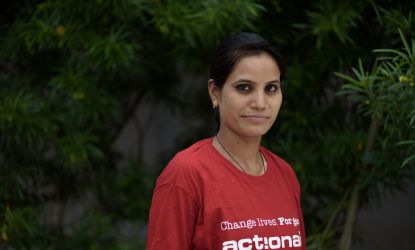
Rani's story: from domestic violence survivor to women’s support worker
Rani, 25, from Bhopal, India, was physically abused by her husband who she married aged 15.
When Rani was pregnant with her second child, her husband hit her so badly that her liver stopped functioning properly and she received permanent damage to her head.
Rani found the courage to leave her abusive husband and seek support from the ActionAid Gauravi One-Stop Crisis Centre in Bhopal.
“The centre supported me medically and they got me checked out by a doctor,” she says. Rani also received legal support.
I am not fearful of anybody now. I am fearless today.”
The Gauravi One-Stop Crisis Centre encouraged Rani to study for a degree, and gave her a job at the centre.
She now receives as many as 100 calls a day from women experiencing violence and arranges counselling sessions for them.
Rani is a survivor of domestic violence and now works at the Gauravi One-Stop Crisis Centre in Bhopal, India.
Smita Sharma/ActionAid
The effects of intimate partner violence on women’s health
Domestic violence has devastating consequences for women and girls.
Women who have been physically or sexually abused by their partners are more than twice as likely to have an abortion, almost twice as likely to experience depression and, in some regions, 1.5 times more likely to acquire a sexually transmitted infection (STI) or HIV.7
Other physical and mental impacts of domestic violence include injury, chronic pain, suicide, post-traumatic stress disorder, neurological disorders, anxiety, alcohol and substance abuse – and death.
The effects on children and babies
Violence during pregnancy has been associated with miscarriage, stillbirth, premature labour and birth and low birth weight, according to the World Health Organisation.8
Domestic violence and women's economic independence
There are multiple issues that prevent women from leaving abusive relationships, including shame, denial, lack of self-confidence and fear for their safety.
However, for women and girls living in poverty, the biggest barrier to them leaving is usually financial dependence on their partner. Many women struggle with economic security and rely on their combined incomes with other family members or husbands in order to make ends meet for them and their children.
He used to slap me in the streets at night or at his place. I didn't report anything I just let things be. What's the point of reporting someone who is feeding you?”
Grace's quote highlights the way economic inequality enables control and domination, and can force women and girls into a situation where they have to suffer through abuse or face hunger or destitution.
Empowering women to generate their own income and have financial independence is therefore an essential part of ending domestic violence.
Domestic violence and unintended pregnancy statistics
14,100
ActionAid estimates that by reducing domestic violence by partners, 8.4 million unsafe abortions could be prevented - saving an estimated 14,100 women’s lives - the majority in sub-Saharan Africa.9
15%
Overall, the proportion of unintended pregnancy that can be attributed to domestic violence by partners is 15%.9
40%
Reducing domestic violence by partners by 50% could potentially reduce unintended pregnancy by up to 40%.9
Domestic violence and women's sexual and reproductive health and rights
Men can use violence to dominate their relationships economically, physically, psychologically and sexually. This denies them their sexual and reproductive health and rights, making it extremely difficult for women and girls to prevent unintended pregnancy.
Rape, fear of violence when or if women refuse sex, and difficulties negotiating contraception and condom use all increase the likelihood of women and girls having unintended pregnancy, as well as catching sexually transmitted infections, including HIV.
Complications during pregnancy and childbirth are the second highest cause of death for girls aged 15-19 worldwide.12
By giving women and girls access to family planning services we can support women to control the number of children they have – helping increase their independence and ability to stand up to abuse or leave abusive relationships.
Since I started working I have the money to buy contraceptives because I am self-employed. I can now refuse my husband when he demands sex if I am not in the mood. I haven't told him my husband I'm using contraceptives yet.”
However, as we can see from Beatrice’s comment – even when women are able to address some power imbalances and violence within their relationship, there is still fear of reprisal when it comes to speaking about contraception.
This highlights how empowering women economically is not enough. We must promote women's sexual and reproductive health and rights and address the power imbalances in relationships which are at the heart of the issue.
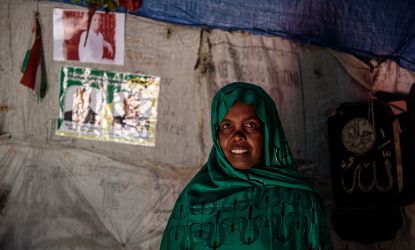
Nimah faced threats for supporting survivors of domestic violence
Nimah, 40, has been volunteering with a women’s rights coalition - a partner of ActionAid's - for almost a decade in Hargeisa, Somaliland. As the chairwoman in her area she supports domestic violence survivors, but her work has made her the target of threats.
Nimah says angry husbands often tell her not to interfere and one man even threatened to rape her. When faced with violence she often relies on the police to help her.
But despite the challenges she faces, Nimah continues supporting survivors because she sees all women as her sisters. Nimah and her network of volunteers let it be known within the community that they are there to help women.
Survivors of domestic abuse then approach them and get various forms of help. This could include being given a space in a safe house, getting paralegal support or receiving literacy training.
Nimah Osmail Mohamed, 40, is the chairwoman for alocal women's coalition and helps domestic violence survivors in her community in Hargeisa, Somaliland.
Jennifer Huxta/ActionAid
How ActionAid is ending domestic violence
Local ActionAid staff across Africa, Asia and Latin America are working to end domestic violence. Through local women's groups and girls' clubs, we empower women and girls to know their rights – especially their right to make choices about their own bodies.
By funding local women's organisations, we help provide vital information and support services for survivors of domestic violence. We support organisations who investigate domestic violence cases and take perpetrators to court to ensure they are brought to justice.
We work to end harmful traditional practices such as child marriage that create relationship power imbalances where domestic violence is common.
We do research on issues such as the link between domestic violence and sexual reproductive health and rights (PDF), and make recommendations to governments.
ActionAid also campaigns at a regional, national and international levels to end all forms of violence against women and girls.
Have you been affected by domestic violence?
If you or anyone you know has experienced violence, there are services that can help. You don't have to report the assault to police if you don't want to.
These services may be able to help you:
24-hour National Domestic Violence Helpline - 0808 2000 247
A 24-hour national service for women experiencing domestic violence, as well as for their their family, friends, colleagues and others calling on their behalf.
Rape Crisis – 0808 802 9999
A free national helpline for women and girls who have experienced abuse, rape and all forms of sexual violence.
Galop, the LGBT+ anti-violence charity
Support for LGTB+ women, men and non-binary people who have experienced hate crime, sexual violence or domestic abuse. They also have a dedicated service for trans people.
The Survivors Trust
Support for all survivors of rape, sexual violence and childhood sexual abuse, no matter how long ago it happened.
Childline - 0800 1111
Free help and advice to anyone under the age of 19.
Footnotes
- 1
www.who.int/news-room/fact-sheets/detail/adolescent-pregnancy
- 2
https://childmarriagedata.org/global-trends/
- 3https://www.unodc.org/documents/gsh/pdfs/2014_GLOBAL_HOMICIDE_BOOK_web.pdf
- 4https://www.unicef.org/mena/press-releases/new-global-data-on-violence-against-children
- 5apps.who.int/iris/bitstream/handle/10665/85239/9789241564625_eng.pdf;jsessionid=2FDC1C853CCBDB28EF867C581E345E3D?sequence=1
- 6United Nations Office for the Coordination of Humanitarian Affairs, United Nations High Commissioner for Refugees and International Rescue Committee (2012). Gender-Based Violence Classification Tool. 1st ed. [ebook] Gender-based Violence Information Management System Project.
- 7http://www.who.int/news-room/fact-sheets/detail/violence-against-women
- 8http://www.who.int/violence_injury_prevention/violence/global_campaign/en/chap4.pdf
- 9a9b9chttp://www.actionaid.org/sites/files/actionaid/actionaid-familyplanning-report.pdf
- 12https://data2.unhcr.org/en/documents/download/59751
Page updated 5 January 2026
